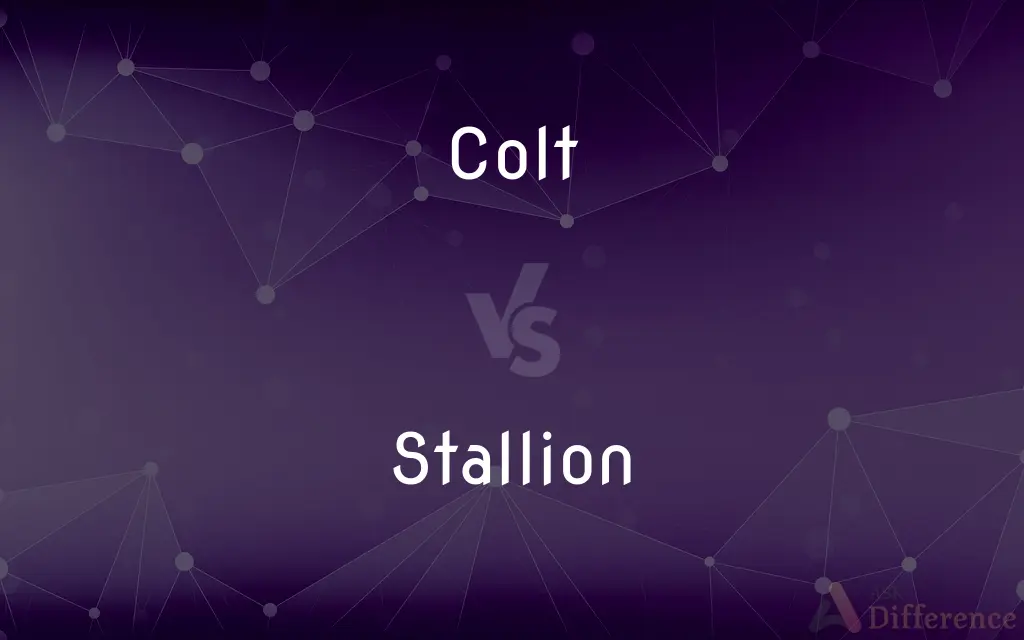Colt vs. Stallion — What's the Difference?
Edited by Tayyaba Rehman — By Fiza Rafique — Updated on April 3, 2024
A colt is a young male horse under 4 years, focused on growth and learning, while a stallion is a mature male, known for breeding and its vigorous temperament.

Difference Between Colt and Stallion
Table of Contents
ADVERTISEMENT
Key Differences
A colt is typically under the age of four years, representing the early stages of a horse's life where development and training are focal points. On the other hand, a stallion is a fully matured male horse, generally over the age of four, recognized for its role in breeding as well as its distinctively strong and often more aggressive behavior.
In terms of temperament, colts are typically more malleable and less aggressive, making them easier to train and handle for many horse enthusiasts. Stallions, by contrast, can exhibit more dominant and challenging behaviors, necessitating experienced handlers to manage them effectively.
Regarding physical characteristics, colts are still growing and may not have reached their full size or muscular development. Stallions, however, are at their peak physical condition, showcasing the full extent of their breed's characteristics, including muscle tone, stature, and sometimes even temperament.
In the social hierarchy of a herd, colts usually have a lower rank due to their age and maturity level. They learn social cues and behaviors from older horses. Stallions often assume a dominant role within a herd, protecting the group and asserting their status through physical displays and behaviors.
Comparison Chart
Age
Under 4 years
4 years and older
ADVERTISEMENT
Purpose
Growth and learning
Breeding and leadership
Temperament
Less aggressive, more trainable
More dominant, can be aggressive
Physical Traits
Still growing, not fully developed
Fully grown, at peak condition
Social Role
Lower rank, learning social cues
Often dominant, protector of herd
Compare with Definitions
Colt
Lower social hierarchy in herds.
The colt followed behind the older horses, learning from their behavior.
Stallion
A mature male horse used for breeding.
The champion stallion was sought after for his exceptional genes.
Colt
In training and development phase.
Training the colt required patience, as it was still learning basic commands.
Stallion
Plays a dominant role within a herd.
The stallion led the herd, always alert to any threats.
Colt
A young male horse under four years old.
The farm was home to several colts, each showcasing the promise of their lineage.
Stallion
Contributes to the genetics of future generations.
As a prized stallion, his offspring were highly anticipated.
Colt
Not yet used for breeding.
The colt, being too young, was separated from the mares during breeding season.
Stallion
Known for vigorous and sometimes aggressive temperament.
Handling the stallion required caution due to his spirited nature.
Colt
Exhibits less muscle and stature.
Compared to the stallions, the colt was noticeably slimmer and smaller.
Stallion
At peak physical condition, showcasing breed characteristics.
The stallion’s muscular build was a testament to his breed’s traits.
Colt
A type of revolver.
Stallion
A stallion is a male horse that has not been gelded (castrated). Stallions follow the conformation and phenotype of their breed, but within that standard, the presence of hormones such as testosterone may give stallions a thicker, "cresty" neck, as well as a somewhat more muscular physique as compared to female horses, known as mares, and castrated males, called geldings.
Colt
A young male horse, especially an ungelded racehorse less than five years old, or a young male of another equine species.
Stallion
Specifically, one that is uncastrated.
Colt
A youthful or inexperienced person; a novice.
Stallion
A male horse kept primarily as a stud.
Colt
A young male horse.
Stallion
A male horse not castrated; a male horse kept for breeding.
Colt
A young crane (bird).
Colt
(figuratively) A youthful or inexperienced person; a novice.
Colt
A professional cricketer during his first season.
Colt
(nautical) A short piece of rope once used by petty officers as an instrument of punishment.
Colt
(biblical) A young camel or donkey.
Colt
To horse; to get with young.
Colt
To befool.
Colt
To frisk or frolic like a colt; to act licentiously or wantonly.
Colt
The young of the equine genus or horse kind of animals; - sometimes distinctively applied to the male, filly being the female. Cf. Foal.
Colt
A young, foolish fellow.
Colt
A short knotted rope formerly used as an instrument of punishment in the navy.
Colt
To frisk or frolic like a colt; to act licentiously or wantonly.
They shook off their bridles and began to colt.
Colt
To horse; to get with young.
Colt
To befool.
Colt
A young male horse under the age of four
Colt
A kind of revolver
Common Curiosities
What is a colt?
A colt is a young male horse under four years of age.
What defines a stallion?
A stallion is a fully matured male horse, usually over four years old, often used for breeding.
Why are stallions known for being aggressive?
Stallions can be more aggressive due to their role in nature to breed and protect the herd, which involves asserting dominance.
Are colts or stallions better for beginners?
Colts, being less aggressive and more trainable, might be better suited for beginners than stallions.
Do stallions have a specific physical appearance?
Yes, stallions typically exhibit a more muscular build and pronounced features than colts or geldings.
What makes stallions valuable for breeding?
Stallions are valued for their genetic traits, physical attributes, and temperament, which are passed on to their offspring.
How do colts learn social behavior?
Colts learn social behavior by interacting with the herd, observing and mimicking the actions of older horses.
What is the role of a stallion in a herd?
A stallion often serves as the protector and leader of a herd, maintaining order and breeding with mares.
How can one tell the difference between a colt and a stallion?
Age, physical maturity, and behavior are key indicators; colts are younger and less developed, while stallions are mature and more assertive.
Can a stallion be trained to be less aggressive?
Yes, with experienced handling and training, a stallion's aggression can be managed.
Is there a difference in the dietary needs of colts and stallions?
Yes, colts may require a diet focused on growth, while stallions need a diet that maintains their physical condition and supports breeding capabilities.
What responsibilities come with owning a stallion?
Owning a stallion requires experienced handling, secure housing, and attention to breeding management and temperament control.
Share Your Discovery

Previous Comparison
Extraction vs. Abstraction
Next Comparison
Tradition vs. TraditionalAuthor Spotlight
Written by
Fiza RafiqueFiza Rafique is a skilled content writer at AskDifference.com, where she meticulously refines and enhances written pieces. Drawing from her vast editorial expertise, Fiza ensures clarity, accuracy, and precision in every article. Passionate about language, she continually seeks to elevate the quality of content for readers worldwide.
Edited by
Tayyaba RehmanTayyaba Rehman is a distinguished writer, currently serving as a primary contributor to askdifference.com. As a researcher in semantics and etymology, Tayyaba's passion for the complexity of languages and their distinctions has found a perfect home on the platform. Tayyaba delves into the intricacies of language, distinguishing between commonly confused words and phrases, thereby providing clarity for readers worldwide.














































